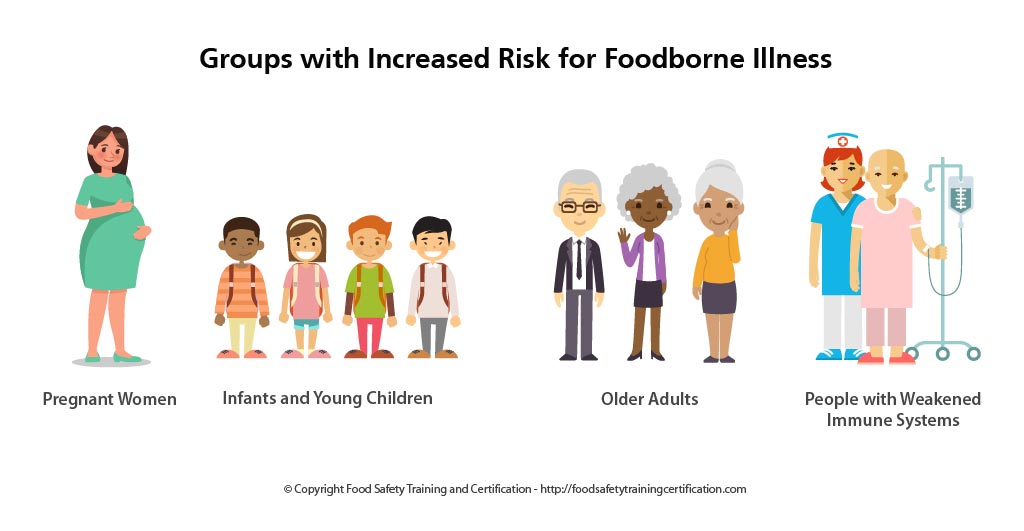Food contamination refers to food that has been defiled by a harmful microorganism, toxin, substance, or object.
Contamination of food can happen at any point of production and can be caused by a variety of factors including: environmental, agricultural, industrial, infected food handling personnel, or the improper holding times/temperatures in the handling, preparing, and storing of food.



Types of Food Contamination
A food contaminant is any harmful or poisonous agent (biological, chemical, or physical) – that is not naturally inherent to the food itself – in an amount that has the potential to pose a threat to human health or cause illness.
- Learn about proper hygiene, cross contamination, cold and hot food safety, foodborne pathogens, and best practices to prevent foodborne illness.
- Food Manager Training & ANSI Certification - $99.00
- Food Handler Training - only $7.00!
- HACCP Training: 16hr/4hr/1hr
- Food Allergy Training - $15.00
- Enter Promo "train10off" at Checkout
- Biological Contamination
Biological contamination includes food contaminants (hazards) such as: bacteria, viruses, and parasites. Bacteria and viruses are responsible for most foodborne illnesses and are the biggest threat to food safety. - Chemical Contamination
Chemical contamination includes food contaminants (hazards) such as: natural toxins (algae, fungi, molds, plants, allergens) and chemical contaminants (pesticides, industrial chemicals, cleaning and sanitizing agents, food additives, drugs, and other toxins).
- Allergenic Hazards: Food allergens are a sub-category of natural toxins within chemical hazards. Some people are sensitive to certain proteins in foods. The 8 major food allergens include: milk, eggs, fish, crustacean shellfish (lobster, crab, shrimp), wheat, soy, peanuts, and tree nuts.
- Physical Contamination
Physical contamination includes food contaminants (hazards) such as: foreign objects which include glass, metal, plastic, bone chips, hair, insects, pest droppings, and other undesirable particles or objects.



Symptoms of Foodborne Infections
Symptoms of foodborne illnesses generally depend on the cause or type of agent. Most foodborne illnesses, while unpleasant, go away by themselves and don’t have lasting effects.
The most common result of biological foodborne infections is gastroenteritis. Gastroenteritis, also called the “stomach flu”, is the inflammation of the gastrointestinal tract – the stomach and small intestine.
Symptoms of gastroenteritis include abdominal pain, vomiting, diarrhea, headache, fever, and chills. The onset of symptoms can last from a few hours to several days. Most people recover with no treatment.
The most common problem with gastroenteritis is dehydration. This happens by not drinking enough fluids to replace those lost through vomiting and diarrhea.



Foodborne Illness Types
Foodborne illness are classified or categorized in various different ways; e.g. type of foodborne pathogen, type of microorganism, most common, most deadly, or the type of illness they afflict on humans.
Foodborne illnesses are generally categorized by the type of illness they create:
Foodborne Infection: A foodborne infection is caused by eating food contaminated pathogenic (harmful) microorganisms – such as bacteria, parasites, or viruses – which invade and multiply in the intestinal tract or other tissues – and cause illness. Bacteria causing infections include Salmonellosis and Listerosis. Viruses include Hepatitis A, and norovirus. Parasites include Trichinella and Anisakis.
Foodborne Intoxication: Foodborne intoxication is caused by consuming food containing either poisonous chemicals or toxins produced by microorganisms in the food. Poisonous chemicals causing illness are substances such as cleaning compounds, sanitizers, pesticides, and heavy metals. Examples of toxin producing bacteria include Clostridium botulinum, Staphylococcus aureus, and Clostridium perfringens. Toxins are also the natural part of some plants and mushrooms. Seafood toxins include ciguatera and scombroid.
Foodborne Toxin-mediated Infection: Foodborne toxin-mediated infections are the result of eating food containing harmful microorganisms – which then produce toxins while in the intestinal tract. Viruses and parasites do not cause toxin-mediated infections. Bacteria such as Shigella and Shiga toxin-producing E. coli cause toxin-mediated infections.



Vulnerable Groups
As with all foodborne illnesses, certain populations are more susceptible to becoming ill or developing a greater severity of the illness. These groups include:
- Pregnant women;
- Infants and young children;
- Older adults;
- People with weakened immune systems from medical conditions, such as diabetes, liver disease, kidney disease, organ transplants, or HIV/AIDS;
- People taking certain kinds of medications for medical conditions – or receiving chemotherapy or radiation treatment.



References
- FoodSafety.gov – Bacteria and Viruses
https://www.foodsafety.gov/poisoning/causes/bacteriaviruses/index.html - The National Institute of Diabetes and Digestive and Kidney Diseases Health Information Center
https://www.niddk.nih.gov/health-information/digestive-diseases/foodborne-illnesses - CDC – Food Safety
https://www.cdc.gov/foodsafety/foodborne-germs.html - U.S. FDA – Foodborne Illnesses
https://www.fda.gov/food/consumers/what-you-need-know-about-foodborne-illnesses - U.S. FDA – Foodborne Pathogens
https://www.fda.gov/food/outbreaks-foodborne-illness/foodborne-pathogens - U.S. National Library of Medicine – Medline Plus – Bacterial Infections
https://medlineplus.gov/bacterialinfections.html - Centers for Diseases prevention and Control (CDC) – Norovirus
https://www.cdc.gov/norovirus/trends-outbreaks/burden-US.html - Mayo Clinic – Noroviros Infection
https://www.mayoclinic.org/diseases-conditions/norovirus/symptoms-causes/syc-20355296 - CDC- Parasites:
https://www.cdc.gov/parasites/ - U.S. National Library of Medicine – Medline Plus – Parasitic Diseases
https://medlineplus.gov/parasiticdiseases.html - FDA – Fish and Fishery Products Hazards and Controls Guidance
https://www.fda.gov/food/seafood-guidance-documents-regulatory-information/fish-and-fishery-products-hazards-and-controls-guidance-4th-edition - USDA – Parasites and Foodborne Illness
https://www.fsis.usda.gov/wps/portal/fsis/topics/food-safety-education/get-answers/food-safety-fact-sheets/foodborne-illness-and-disease/parasites-and-foodborne-illness/






